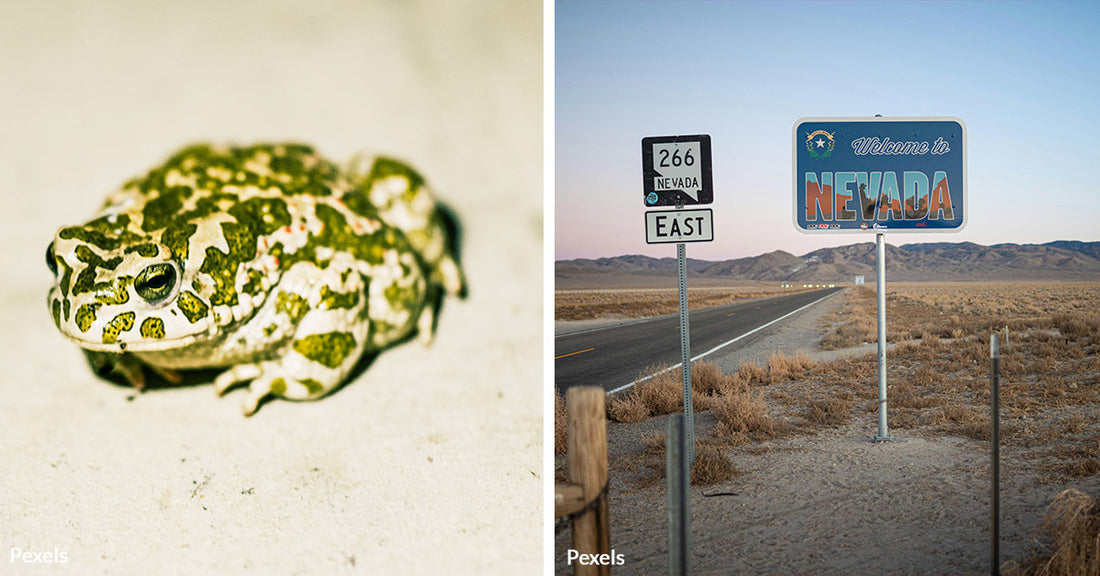Rare Desert Toad Fights for Survival Against Encroaching Lithium Mining Development
Matthew Russell
In the remote expanses of Nevada's Railroad Valley, a small but critical battle for survival unfolds. The Railroad Valley toad, a species recently distinguished in 2020, faces a precarious future.
With a habitat confined to a mere 445 acres of spring-fed wetlands at Lockes Ranch, this toad's existence hangs by a thread.
 Photo: Pexels
Photo: PexelsThis Railroad Valley toad inhabits a single spring-fed wetland complex.
Habitat and Characteristics
The Railroad Valley toad, known scientifically as Anaxyrus nevadensis, is one of the smallest in its genus, according to Herpedia. It boasts a distinctive brownish-gray color, flecked with irregular dark spots, and a unique mottling on its underside. Unlike its relatives, this toad lacks an advertisement call, relying on release calls during close encounters in the breeding season. Its habitat, fed by Big, Reynolds, and Hay Corral springs, is a marshland oasis amidst the arid Nevada desert, limiting its ability to disperse to other water sources.
 Photo: Pexels
Photo: PexelsThe Railroad Valley toad is endemic to Nevada's Railroad Valley.
Threats to Survival
The toad's survival is jeopardized by several factors. According to the Center for Biological Diversity, oil and gas extraction activities, prevalent in the Railroad Valley, pose a significant threat to the wetlands that sustain the toad. Moreover, a proposed lithium project, aiming to extract billions of gallons of groundwater annually, looms ominously close to the toad's habitat. This project not only risks depleting the water resources but also threatens to degrade water quality through the reinjection of post-processed brine.
 Photo: Pexels
Photo: PexelsA proposed lithium project could further endanger the toad.
Conservation and Legal Action
In response to these threats, the Center for Biological Diversity has been at the forefront of conservation efforts. A lawsuit was initiated to compel the U.S. Fish and Wildlife Service to extend Endangered Species Act protections to the toad. Despite a petition filed in 2022, the Service has yet to make a determination, prompting legal action due to the missed April 2023 deadline. Such protections are crucial for implementing measures to ensure the toad's survival, including the management of groundwater usage essential for the toad's wetland habitat.
 Photo: Pexels
Photo: PexelsIts habitat spans approximately 445 acres of land in Nevada.
Broader Implications and Expert Insights
The struggle to save the Railroad Valley toad is emblematic of a larger biodiversity crisis. Amphibians globally are under threat, with their populations declining at alarming rates.
“Railroad Valley toads have survived for millennia in a harsh environment, but unless there’s adequate spring flow they won’t make it,” said Krista Kemppinen, Ph.D., a senior scientist at the Center. “Without federal protections their future is bleak. These small amphibians don’t have time for further delays.”
 Photo: Pexels
Photo: PexelsThe Railroad Valley toad It was officially recognized as a distinct species in 2020.
The delicate balance between conservation and development, particularly for lithium essential for renewable energy, presents a complex challenge. Kemppinen further advocates for lithium mining practices that minimize environmental impact and prioritize species conservation.
“[Companies] need to be located in places where they do the least amount of damage, whilst minimizing water consumption, increasing recycling,” Kemppinen said. “We’re definitely not against lithium, because we need lithium for batteries which are needed for electric cars and hybrid cars and storing energy off of solar panels.”
The Railroad Valley toad's plight underscores the intricate interplay between environmental conservation and human development. As efforts to protect this tiny amphibian continue, the broader implications for biodiversity and sustainable development loom large. The outcome of this conservation battle will not only determine the fate of the Railroad Valley toad but also set a precedent for the protection of endangered species amidst the push for renewable energy resources.
Click below and support efforts to protect this species!

